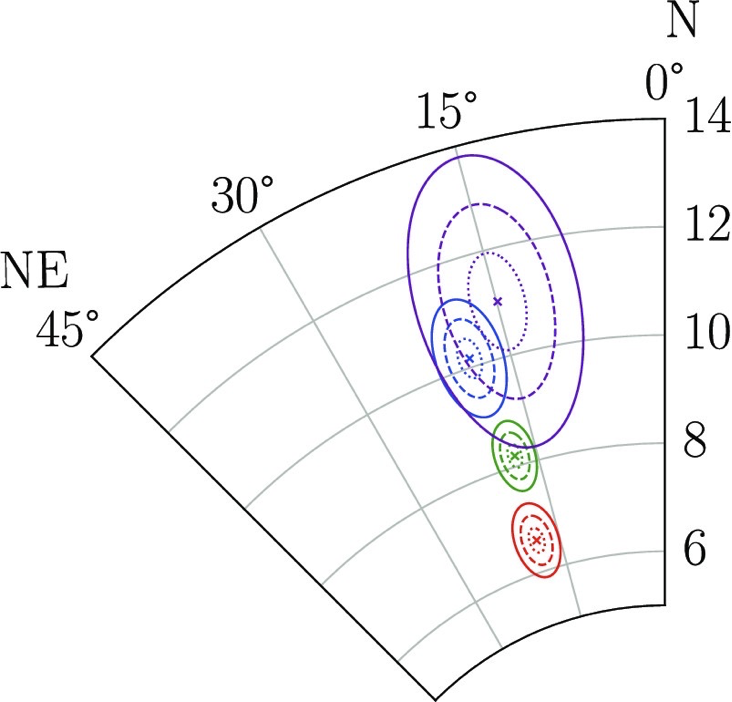NICER / ISS Science Nugget
for June 29, 2023
A NICER take on a polarizing black-hole view
Since its launch in December 2021, NASA's Imaging X-ray Polarimetry Explorer (IXPE) telescope has revealed the previously hidden polarization of X-ray light emitted by black holes and other celestial objects. Polarized light offers a unique benefit in that its electric-field vector maintains a fixed orientation (for linear polarization) as the light propagates through space, so that it directly traces the geometry of the emitting region. Moreover, the degree of polarization -- the fraction of received light that is polarized vs. unpolarized -- carries information about whether the light was reflected, scattered, influenced by magnetic fields, or otherwise transformed near the emission region. An especially powerful combination of measurements is polarimetry with spectroscopy: the latter probes the origin of the emission (for example, the thermal glow of a hot plasma can be distinguished from non-thermal radiation due to accelerated particles) as well as any absorption of light along our line of sight. NICER's spectroscopic capabilities, especially coupled with high throughput and scheduling agility, make it an excellent partner for IXPE.
The accreting black-hole-candidate system known as 4U 1630-47 underwent a relatively bright outburst in the summer of 2022. Both NICER and IXPE observed the system near the peak of the outburst, at a point in its evolution where the emission is thought to be dominated by the innermost parts of the accretion disk -- matter drawn from a companion star by the black hole's strong gravity and heated to million-degree temperatures just outside the event horizon. For the first time, IXPE detected significant polarization in X-rays during this so-called thermal state of a black-hole binary outburst. NICER spectroscopy confirmed the thermal nature of the emission and showed that multiple sources of absorption are present in the system, in the form of an ionized disk "wind" and cooler, neutral material that partially covers our view of the inner accretion disk. These NICER findings anchored a joint spectral-polarimetric analysis of the IXPE data that enabled a deeper interpretation of the polarization results. For example, IXPE measured a higher-than-expected polarization degree, ranging between 6% and 12% as a function of photon energy, while the polarization angle remained constant; NICER's measurements suggest that this is a result of scattering in the absorbing material. Similarly, both NICER and IXPE analyses find that the black hole in 4U 1630 must be rotating at a rate near the maximum allowed (beyond which the event horizon would be forced to co-rotate faster than the speed of light). These results and further interpretation were recently published in the peer-reviewed UK journal Monthly Notices of the Royal Astronomical Society Letters by A. Kushwaha (Rao Satellite Centre, India) and collaborators.


Left: NICER X-ray spectrum model-fitting results for the black-hole binary 4U 1630-47 near the peak of its 2022 outburst. Each panel shows "residuals" -- model predictions subtracted from measured data, scaled by the data error bars -- for successively more sophisticated models from top to bottom. The components of the models are given by the labels "tbabs" (for absorption of X-rays in interstellar gas), "diskbb" (thermal emission from a hot accretion disk), "pcfabs" (a partial-covering absorbing medium near the black hole), "gabs" (a narrow absorption feature such as those in the inset of the top panel), and "kerrbb" (accretion disk emission around a rapidly rotating black hole). The bottom panel represents the best fit to the data, in which all features have been accounted for by the model. (Credit: Kushwaha et al. 2023)
Right: Polarization properties of the black-hole binary 4U 1630-47 as measured by IXPE. The radial axis represents polarization degree (PD) as a percentage of total received X-ray flux, while the tangential axis indicates the orientation (or position angle, PA, on the sky) of the electric field vector for linearly polarized X-rays, where 0 degrees is North. The innermost (dotted), middle (dashed), and outermost (solid) contours show 67%, 95%, and 99.7% confidence intervals for the joint PD and PA measurement, respectively. Contour colors refer to different photon energy ranges: 2-3.5 (red), 3.5-5 (green), 5-6.5 (blue), and 6.5-8 keV (purple). (Credit: Kushwaha et al. 2023)
<< Previous
Main Index
Next >>